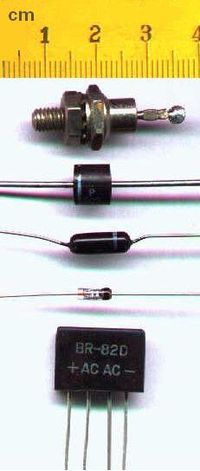In electronics, a diode is a two-terminal electronic component that conducts electric current in only one direction. The term usually refers to a semiconductor diode, the most common type today. This is a crystalline piece of semiconductor material connected to two electrical terminals. A vacuum tube diode (now little used except in some high-power technologies) is a vacuum tube with two electrodes: a plate and a cathode.
The most common function of a diode is to allow an electric current to pass in one direction (called the diode's forward direction) while blocking current in the opposite direction (the reverse direction). Thus, the diode can be thought of as an electronic version of a check valve. This unidirectional behavior is called rectification, and is used to convert alternating current to direct current, and to extract modulation from radio signals in radio receivers.
However, diodes can have more complicated behavior than this simple on-off action. This is due to their complex non-linear electrical characteristics, which can be tailored by varying the construction of their P-N junction. These are exploited in special purpose diodes that perform many different functions. For example, specialized diodes are used to regulate voltage (Zener diodes), to electronically tune radio and TV receivers (varactor diodes), to generate radio frequency oscillations (tunnel diodes), and to produce light (light emitting diodes). Tunnel diodes exhibit negative resistance, which makes them useful in some types of circuits.
Function
Diodes allow electricity to flow in only one direction. The arrow of the circuit symbol shows the direction in which the current can flow. Diodes are the electrical version of a valve and early diodes were actually called valves.Small signal diodes can be damaged by heat when soldering, but the risk is small unless you are using a germanium diode (codes beginning OA...) in which case you should use a heat sink clipped to the lead between the joint and the diode body. A standard crocodile clip can be used as a heat sink.
Signal diodes (small current)
Signal diodes are used to process information (electrical signals) in circuits, so they are only required to pass small currents of up to 100mA. General purpose signal diodes such as the 1N4148 are made from silicon and have a forward voltage drop of 0.7V.Germanium diodes such as the OA90 have a lower forward voltage drop of 0.2V and this makes them suitable to use in radio circuits as detectors which extract the audio signal from the weak radio signal.
For general use, where the size of the forward voltage drop is less important, silicon diodes are better because they are less easily damaged by heat when soldering, they have a lower resistance when conducting, and they have very low leakage currents when a reverse voltage is applied.
Signal diodes are also used to protect transistors and ICs from the brief high voltage produced when a relay coil is switched off. The diagram shows how a protection diode is connected 'backwards' across the relay coil.




No comments:
Post a Comment